We’re always looking for ideas for things. The same is true when it comes to ideas for filler games. So, what are some ideas for filler games?
Here are some ideas for filler games: For Sale, Codenames (all versions), The Resistance (all versions), Coup, Werewords, One Night Ultimate Werewolf (all versions), Love Letter (all versions), Coconuts, Selfish (Both Versions), Machi Koro 1 and 2, Celestia, Dead Man’s Draw, Uk’otoa, Skull, and Incan Gold.
Table of Contents
What Are Filler Games?
A filler game is a game that can fill spots other games can’t during a board game night. This could be a break between games, a warmup before a bigger game, or a way to close out the night with a simple, easy game.
What Makes Good Ideas For Filler Games?
Good filler games need to be short, under 30 minutes, easy to play, easy to teach, and easy to set up.
Ideas For Good Filler Games
Please know these are not the only filler games in existence. There are tons more, and there are tons more coming out every year. These are good filler games, but if you don’t find any to your liking, just know there are a whole lot more!
Also, these are in no particular order; I just listed them as they came to mind. And finally, I’m not going to explain everything about each game; I’m just going to give overviews to give you an idea of how they play. That said, let’s get to the list!
For Sale
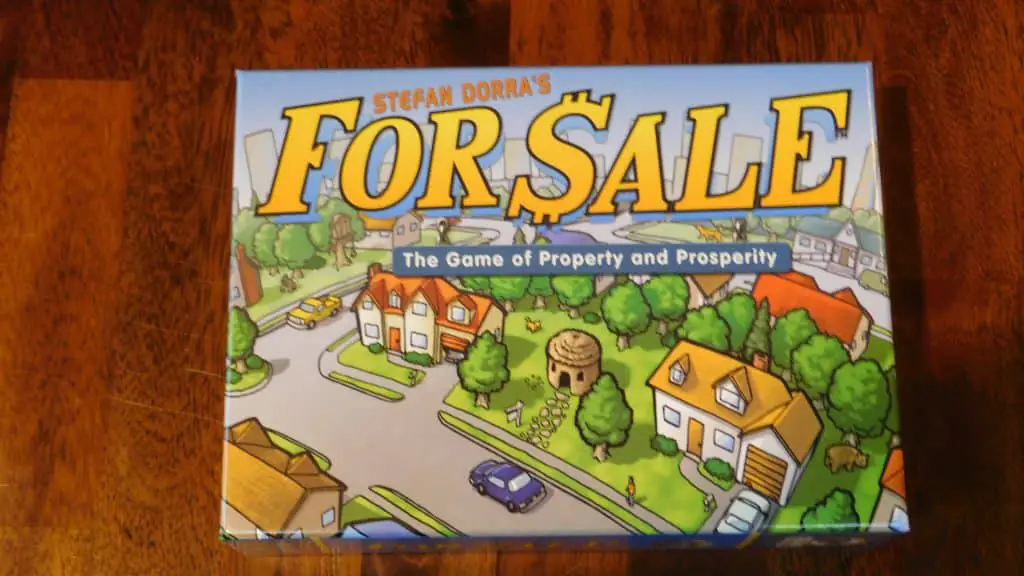
For Sale (also sometimes written as For $ale) was one of the first filler games I ever played, so it made sense to put it on a list of ideas for filler games. This would’ve been many years ago now, but I still remember it to this day, which is a good sign in my mind!
So, what is For Sale? Well, For Sale is a game about buying and selling houses. In the first phase, players bid on houses (a loose term as one card is a cardboard box and another is a space station) as they come up. In the second phase, they try to sell them for as much money as possible, but they have to be careful because other players are competing for the same money. They could end up with nothing for a very expensive house!
All of this takes place on cards that are colorful and easy to understand. The game takes 30 minutes or less to play.
Codenames (All Versions)

Codenames is an awesome game whether it’s on a list of ideas for filler games or by itself. In it, there are two teams ranging from 2 to 4 players per team. In each game, one person on each team is the team leader.
To start, codename cards are laid face up in a 5 by 5 grid pattern. Then two team leaders are chosen, one from each team. Those two people sit by each other so they can see the key card that shows them which cards they want their teams to guess from the grid and which ones they don’t.
From here, starting with the starting team, indicated on the key card, the team leader will give a one-word clue followed by a number. Then their team has to guess which card or cards they think their team leader meant. Whatever they guess, the team leader will put a tile over the card they guessed, showing if they were right, wrong, or they just lost the game!
This is Codenames in a nutshell. It’s fast, fun, and can be a neat, team-based filler game. Plus, there are a lot of versions to suit your interests!
The Resistance (All Versions)

The Resistance was one of the first party games I was introduced to a long, long time ago. So, you might see me call it a party game and wonder why it’s on the list of ideas for filler games. That’s because it does both so well!
How To Win The Resistance
In The Resistance, everyone is supposed to be on the same team. However, depending on how many players, there are one or more traitors. Each game has five missions, and in order to win either the traitor team or the resistance team needs to win 3 of those missions.
How To Play The Resistance
For each mission, there is a team leader. That team leader picks, however, many people the mission calls for to be part of the mission team. They can pick themselves or others or some combination of the two.
Then everyone votes on if they want that team to go on the mission or not. If the team goes on the mission they each put one facedown card in a pile. That pile is shuffled and then revealed by the team leader.
If even one card comes up a “fail”, then the mission fails. If all the cards come up a “success”, then the mission succeeds.
Now, if the team was rejected during the vote, then the player to the left of the team leader becomes the new team leader and the process starts over. At all times, people are allowed to talk, make guesses as to who the traitors are, and explain their thinking about the things they’re doing. Or they can choose to say nothing.
This game is hilarious and will have people rolling with laughter. Some versions do play a little differently from what I described above, but, for the most part, this is how The Resistance goes.
Coup
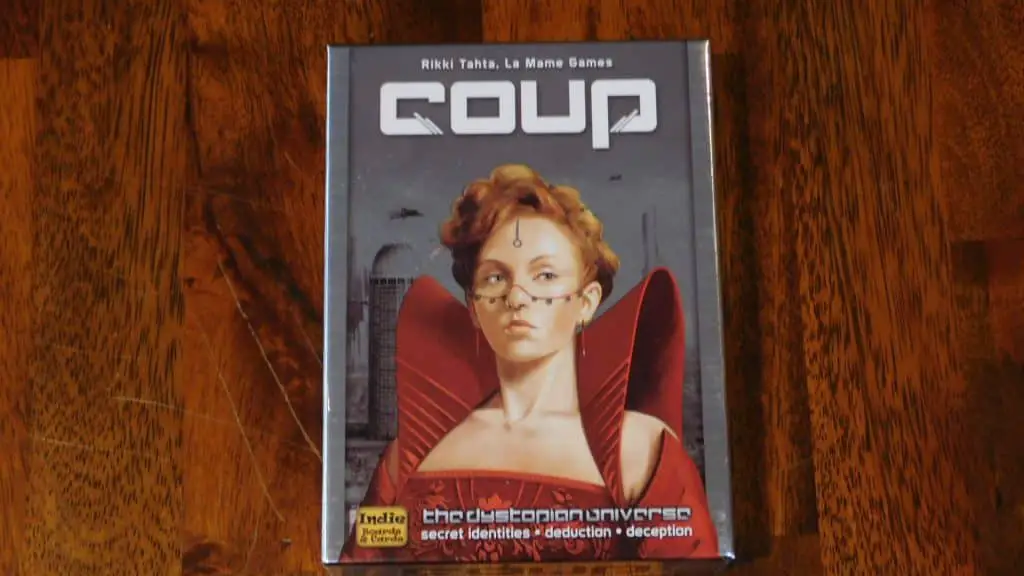
Way back in the day Coup was a bit of a cult game. Then it was picked up and turned into the popular game it is today. So, what is Coup?
Well, aside from being another great choice for ideas for filler games, in Coup you will only ever have 2 cards. To begin, those cards are facedown. Each card has a special power that can be used on your turn.
What makes Coup interesting is that you can use a special power that you actually don’t have the card for. It’s called bluffing in the game, and it’s wonderful. However, other players can challenge your use of a special power too, so you have to be careful.
On your turn, you can either do one basic action that everyone can do, but they’re generally not as powerful as the special power actions. You can also use a special power action associated with a card you may or may not have. Also, as you gather money in the game, you can launch a coup against another player, which forces them to turn over a card.
Ultimately, you win Coup by being the last player with at least one facedown card. The nice thing is that this game plays so fast you can play a lot of sessions in a row!
Werewords
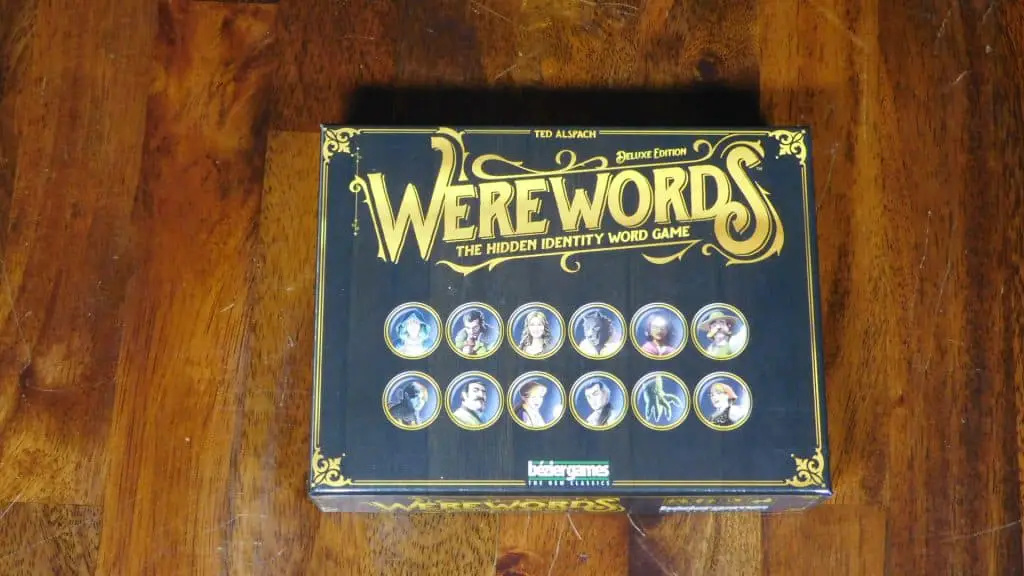
Werewords is one of my personal favorite party and filler games, so it’s a great choice for this list of ideas for filler games. It doesn’t seem like it should be so good, but it took the basic Werewolf formula and turned it into something even more hilarious and special.
In Werewords, everyone has a secret role that either puts them on the werewolf team or the villager team. In each game, there’s a secret word that only a few people know: the werewolf or werewolves, the seer on the villager team, and the mayor.
During the game, everyone will be asking the mayor yes or no questions to try to figure out what the word is. The mayor cannot speak or gesture, but does have double-sided tokens with a checkmark and an X. If the question the player asked resulted in a yes, they get a token with a check mark, and if the question resulted in a no, they get a token with an X.
There are also question mark tokens that act as a maybe answer, and there are some special tokens too for very specific situations.
Now, the werewolf or werewolves can try to ask questions that lead the villager team away from the right answer, but they have to do so without giving themselves away. The same is true of the seer except they want to help lead the villagers to the right answer.
Since the game is timed and you can run out of questions, either the villagers have to vote on who the werewolf or werewolves are or the werewolf or werewolves have to guess who the seer is.
I cannot overstate just how awesome this game is. Give it a shot!
One Night Ultimate Werewolf (All Versions)
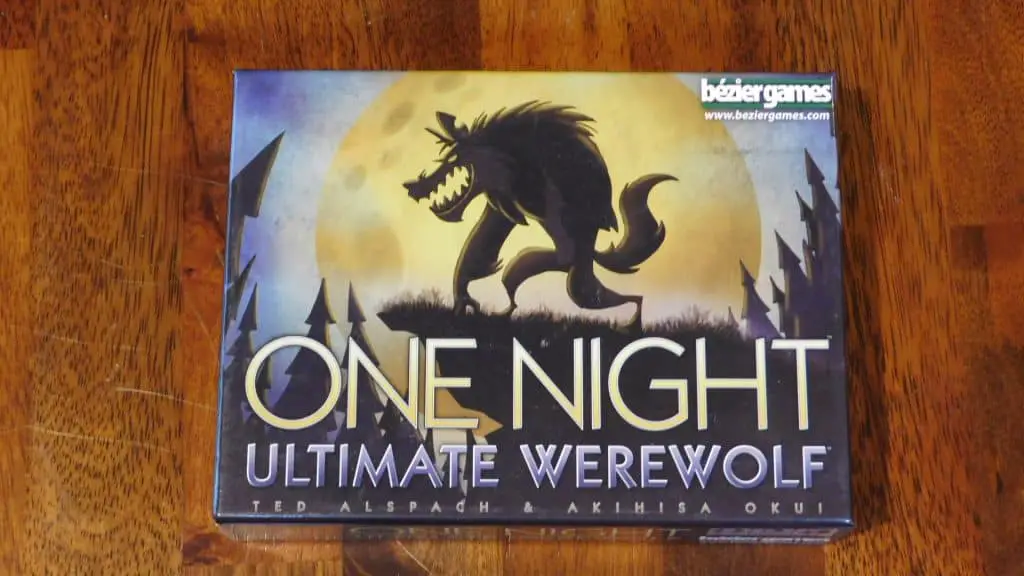
One Night Ultimate Werewolf, usually just called One Night Werewolf, is one of the best party games ever. It’s also a fantastic choice for this list of ideas for filler games.
It’s similar to The Resistance and Werewords, but it takes place much faster. In fact, it’s only one round! Most games will last no more than 5-10 minutes total.
At the beginning of the game, everyone gets a secret role tile and 3 tiles are also placed facedown in the center. Using an app (which is easier than a player having to run this part), follow what it tells you to do for each role. During this time all players’ eyes are closed. Afterward, wake up and begin discussing who you think the werewolf or werewolves are.
Players have however much time they set to do this. Once that time is out or if they think they’ve figured it out early, they vote by counting to 3 and then pointing. Whoever has the most votes dies. If all the players who have the most votes are werewolves, then the villagers win, otherwise, the werewolves win.
There are special roles too such as the tanner, who wants to get people to point at him, but whether you use the special roles or not, One Night Werewolf is a blast that will have you laughing and wanting to play it again and again.
There are other versions of the game too, which I haven’t played, so you’ll need to do a little more research there, but I’m going to link them here for ease of finding them. Enjoy!
Love Letter (All Versions)
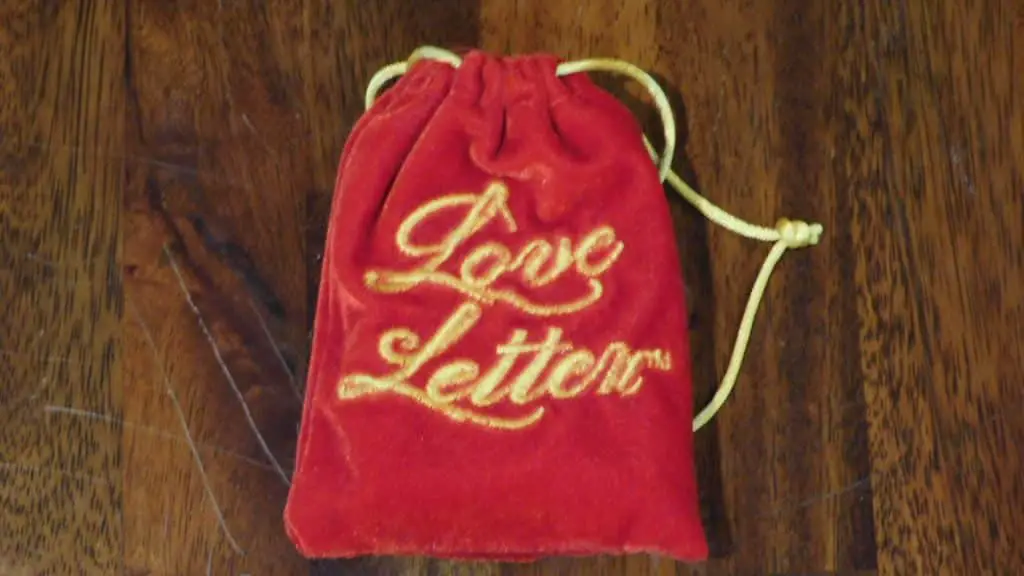
You will only ever have 1 card in Love Letter. On your turn, you draw 1 additional card, then play 1 of the two. Each card has a special power or penalty. Your goal is to be the last one with a card or to have the highest number card at the end of a round.
If you win 3 rounds, then you win Love Letter. That is the entire game and yet somehow it continues to be surprising and fun even all these years later. Plus, there are tons of versions of this game.
I highly recommend it if you’re looking for something super simple, easy, and you can get a lot of plays out of.
Coconuts

Coconuts has a great table presence; it just looks great and is super fun to play. So, it was an easy choice for me to include on this list of ideas for filler games.
In Coconuts, you have a player board, a plastic monkey, and some rubber coconuts. On your turn, you put a rubber coconut in the monkey’s hands, pull those hands down, then let the coconut fly. Your goal is to land the coconut in one of the red or yellow cups in the center of the table.
If you do manage to land a coconut in one of the cups, you put it on your player board. Once you have 6 cups stacked up, you win! Or, if everyone runs out of coconuts before getting 6 cups, then the player with the most coconuts in their cups wins.
There are some wrinkles here though. For one, you have to fire from behind the line shown on your player board. For two, if you get a coconut in a red cup then you get to take a second shot.
Another interesting aspect of the game is that players can also aim for your cups. If they get a coconut in your cup, they steal it!
Coconuts is a fantastic, silly game. Expect to miss a lot and have a blast and it’ll be a great time.
Selfish (Both Versions)
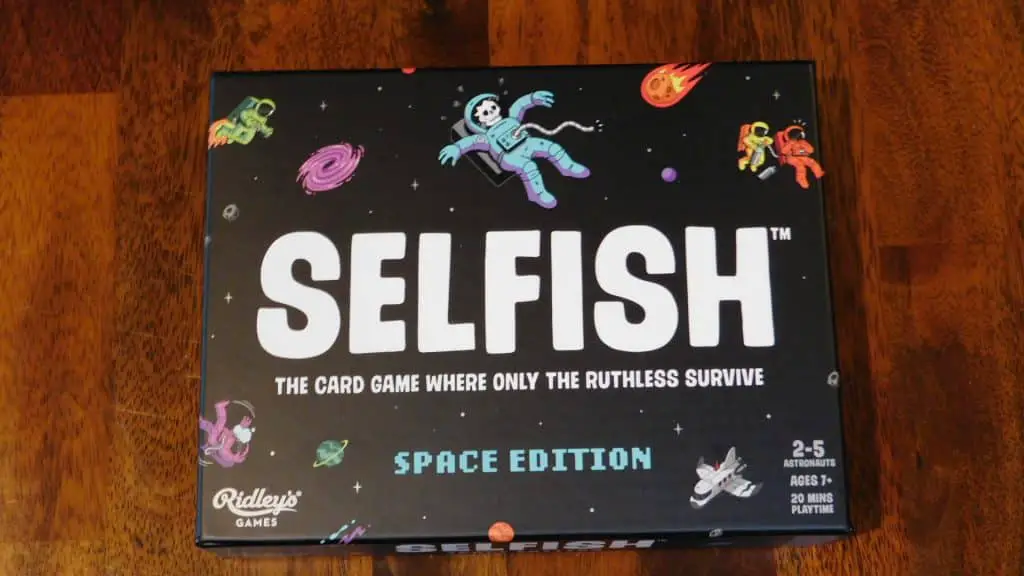
Selfish is similar to the game, Among Us, a popular video game. There’s even a space edition of Selfish!
In Selfish, your goal is to get to a safe zone. If you do, you win. If not, you lose.
On your turn, you draw a card, then you can play as many or as few action cards as you want, then you have to decide if you’re going to stay where you are or keep moving. If you stay where you are, you give up 1 supply or oxygen card (depending on if you’re playing the zombie or space edition). If you move, you give up 2 cards.
Also, if you move forward, you reveal a new wasteland or space card, again depending on what game you’re playing. The card you reveal could be bad or good or a bit of both.
It is possible to die in the games, but they play so fast that it doesn’t really matter. They’re hilarious and a ton of fun. I’d recommend either one.
Machi Koro 1 and 2
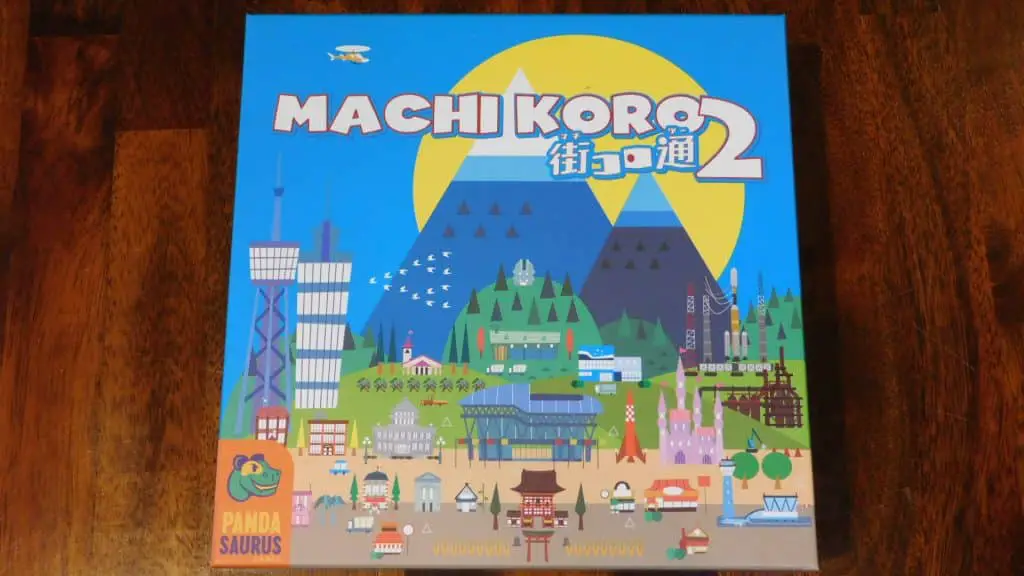
The first time I played Machi Koro, I played it about 6 times in a row. Since then, it doesn’t come out as much, but it is still a game I keep around because it’s fast, fun, and easy to play.
Your goal in the game is to build 4 landmarks. Each landmark gives you a special ability for the rest of the game too, so deciding which ones to build when is a part of the strategy of the game.
On your turn, you roll 1 or 2 dice. Every card (except landmarks) has a number at the top and a color. Green cards only activate on your turn, blue cards activate on everybody’s turn, and red cards only activate on other players’ turns.
Whatever number you rolled on your die or dice, those cards activate. Almost all of the time, this is to give you money. After figuring all that out, then you buy a card from the center to add to your engine or you build a landmark. And that’s it!
Machi Koro is very fun, but you may want to buy some extra dice since the game only comes with 2; Machi Koro 2 takes what Machi Koro 1 did and updates and tweaks it a little.
Celestia

Celestia is one of my favorite games whether I’m using it as a filler or more of the main game for the night. I have played this game many times in a row with different people and we’ve had a blast each and every time. So, what is it?
Celestia is an updated version of a game called Cloud 9. Celestia has much better art and also has a couple of small expansions to boot. In Celestia, your goal is to get the most points over 50.
All player pawns will be in a little 3D cardboard ship. Each turn, the ship will either move to the following location or it will crash and go back to the start.
Each turn, one player is the captain. They roll the number of dice shown on the next location in front of the ship, then, starting with the player to the left of that player, each player except the captain decides if they want to stay on the ship or jump out. Essentially, they have to decide if the captain has the right cards to match the symbols that came up on the dice.
The captain can lie either way, saying they do have the right cards when they don’t or saying they don’t when they do. Either way, unless the captain has a special power card, they’re going down with the ship.
All players who are on a ship that crashes get nothing, but the players who jump out get some points. The earlier locations offer very little points while the later locations offer more points. It’s a great game, and I highly recommend it.
Dead Man’s Draw
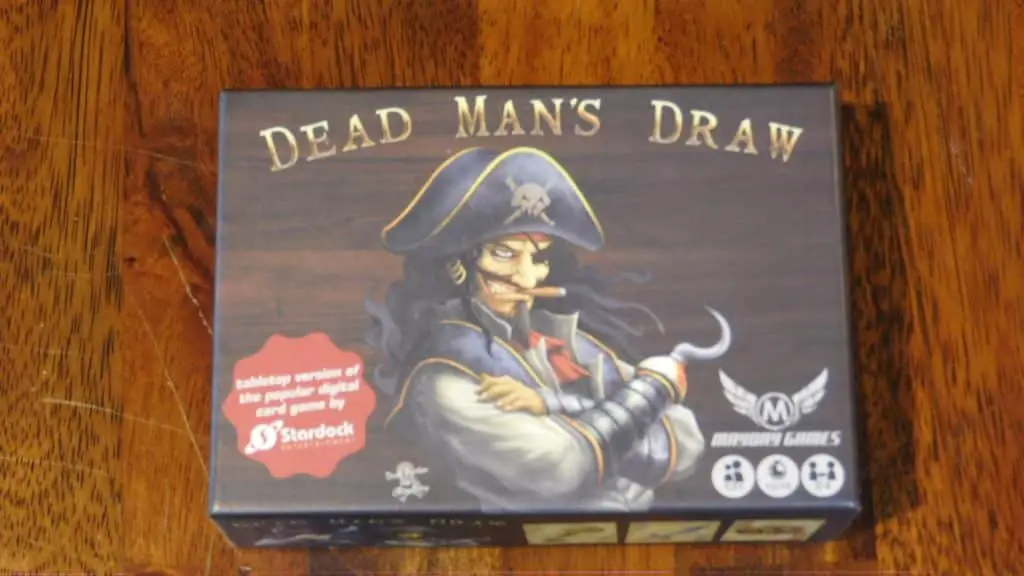
Dead Man’s Draw is another one of my favorite games. It might be the most-played game of mine on this list actually.
First of all, Dead Man’s Draw has beautiful art. Second of all, it plays fast and is super fun too.
In Dead Man’s Draw, you shuffle the deck of cards and place it in the center. On a player’s turn, they must draw the top card and flip it over. They must do whatever special action is associated with that card.
After completing the special action, they can bank that card or draw another. If they draw another, they have to complete that new card’s special action, and if they continue to draw and ever draw two of the same card symbol, they bust and lose all their cards.
If they bank, they sort the cards by symbol and stack them up with the highest number showing. Once the deck is empty, every one counts only the top card of each stack, adds them up, and sees who wins!
Uk’otoa

I recently reviewed Uk’otoa, so if you’re interested in more information about the game, head over here. Otherwise, let me give you a quick rundown of this nautical-themed game.
In Uk’otoa, you and the other players control sailors from different-colored groups. All the sailors are on a ship that is sinking, represented by tiles. Uk’otoa is a legendary sea monster that is slowly eating the tiles and the sailors.
Your goal is to maneuver your sailors and Uk’otoa around so that only the colors you control are left alive. You do this by playing cards. What’s interesting is that every color sailor you control is also controlled by another player too, so how you manage this gets really, really interesting.
Skull

In Skull, every player gets 4 coasters and one tile to place them on. They shuffle those coasters and then place them facedown next to their tile. Then, one at a time, they can either add a coaster facedown (of their choice) to their tile or they can issue a challenge.
If they issue a challenge, they say the number of coasters they are going to flip over. The other players then have a chance to increase that bid by 1 or more or they can pass. The player with the highest bid goes by flipping over all their coasters, then the next player’s, and so on.
If they flip over any skulls, they have failed and lost one of their own coasters for good. If they lose their last coaster, then they lose the game. However, if they flip over no skulls, then they succeed. If they get two successes, then they win!
Skull has the look and feel of a great beer-and-pretzels kind of game. Give it a shot if you’re looking for something fun but with a slightly mature feel.
Incan Gold
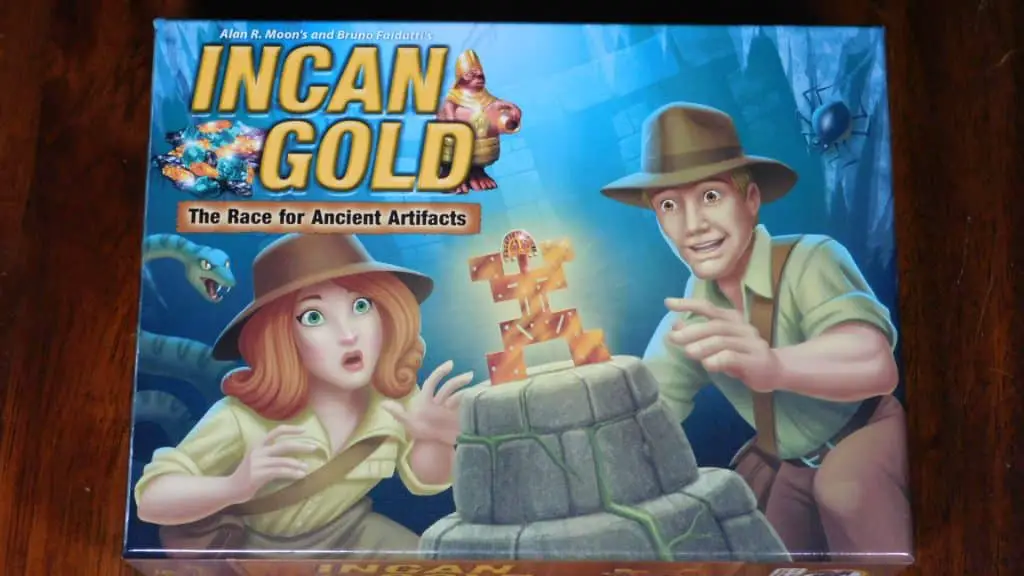
Incan Gold is an old favorite of mine. Your only choice in the game is to either stay in the round or opt-out and take what treasure you can.
In each round, one player will be flipping over cards one at a time. Sometimes those cards have a number in which case they place that number of gems on the card. Sometimes those cards have traps. If two traps come up during that round, then the round is over and everyone still in gets nothing.
When a player opts to leave (which they all decide to do secretly and at the same time), if they’re the only ones to leave, they get all the gems on the cards. If multiple people leave, they split up the gems equally and leave the remainder on the cards. After 5 rounds, the player with the most gems wins!
Ideas For Filler Games – Did You Know?
(Each time you refresh the page you will get a new “Did You Know” fact!)
Did you know that Clue was made in 1947 and was created by Anthony Pratt during World War II? He did it to pass the time during air-raid blackouts. Air-raid blackouts were the practice of shutting everything off to make it as hard as possible for bombers to hit their targets.
Conclusion: Ideas For Filler Games
Whew! That’s a lot of ideas for filler games. As I mentioned before, these won’t be every filler game out there, but this is a great list to get you started.
So, which filler game are you most excited to try first? Which one do you want to try the least? Let us know your thoughts and why you think that in the comments below!
And, as always, keep on gaming, fellow board gamers.

